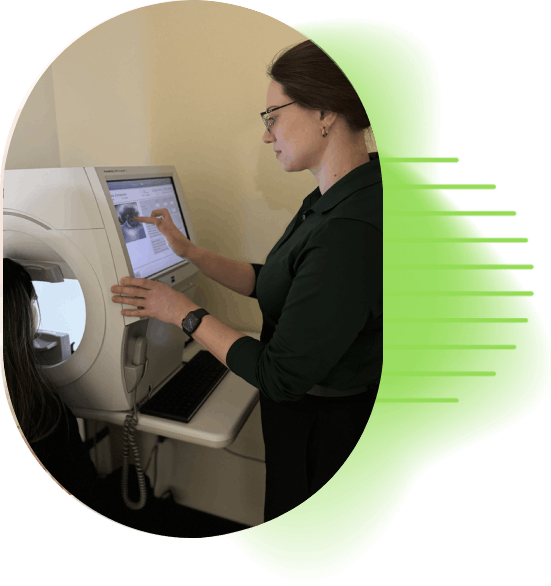Enjoy free shipping on all orders over $150 within Canada! Shop now and save.
Glaucoma & Cataract diagnosis and management in Abbotsford

Eye diseases are conditions that affect the health and function of the eyes. They can cause vision loss, pain discomfort or other problems. They can be developed based on various factors like aging, genetics, injury, inflammation or other factors.
To prevent it, it is important to take care of your eyes and have regular eye exams to detect diseases early and get the appropriate treatment.
Remember, your eye exam is not just about vision check, your optometrist will also check for your eye pressure and eye health using various tests and devices. Your eyes deserve the best!

GLAUCOMA
Glaucoma is a group of eye diseases that can cause vision loss and blindness by damaging the optic nerve. It is one of the leading causes of blindness, affecting more than 450,000 Canadians.
Glaucoma usually develops gradually and has no early symptoms, so regular eye exams are important to detect and treat it early.
types of glaucoma:
There are different types of glaucoma, depending on the cause, the anatomy of the eye, and the pattern of damage.
The two most common types are:
Primary open-angle Glaucoma: Also known as the silent theft of sight because there are no symptoms in its early stages.In this type, the drainage angle of the eye, where the fluid inside the eye flows out, is open but not working properly. This leads to a slow buildup of fluid and pressure in the eye, which damages the optic nerve over time.
Angle-closure Glaucoma: This occurs when the drainage angle of the eye is closed, blocking the fluid from leaving the eye. This leads to sudden or gradual increase of pressure in the eye, causing damage to the optic nerve.
Symptoms of Glaucoma:
Symptoms of glaucoma can vary depending on the type and stage of the condition. However, some common symptoms may include:
Gradual loss of peripheral vision
Tunnel vision (in advanced stages)
Blurred vision
Halos around lights
Severe eye pain
Nausea or vomiting (particularly with acute angle-closure glaucoma)
Redness in the eye
Sudden onset of vision problems (in acute angle-closure glaucoma)
It's important to note that in many cases, especially in the early stages, glaucoma may not present noticeable symptoms until significant vision loss has occurred. This is why regular eye exams, particularly for individuals at higher risk, are crucial for early detection and treatment.
Elevated eye pressure
Increased age
Family history of glaucoma
Physical injury or surgery to the eye
Cardiovascular conditions (such as high blood pressure, low blood pressure, heart conditions, etc.)
Certain eye-related conditions (such as decreased optic nerve tissue, retinal detachment, eye tumors, eye inflammation, etc.)
Medication: The most common initial treatment for glaucoma involves the use of prescription eye drops to reduce the elevated eye pressure.
Surgery: Surgery may help lower the eye pressure when medication is not enough. Some surgical options involve laser trabeculoplasty, drainage implants and laser peripheral iridotomy.
Treatment is usually effective at maintaining vision. However, once vision is lost due to glaucoma, it cannot be restored. Since the disease can progress or change silently, compliance with treatment and routine eye exams are essential.
During your comprehensive eye exam for glaucoma detections, our optometrist will perform:
Tonometry: Tonometry test is used to measure intraocular pressure which is a major risk factor for glaucoma.
Ophthalmoscopy: Optometrist will look for any changes in the appearance of the optic nerve, such as cupping or thinning of the nerve fibers, which may indicate damage caused by glaucoma.
Visual Field Testing: This testing is done to assess the full extent of your peripheral vision. Glaucoma typically causes gradual loss of peripheral vision, so visual testing can help detect early signs of the condition.
Optical Coherence Tomography: OCT is a non-invasive test that provides detailed images of the retina, optic nerve which can detect thinning of the retinal nerve fiber layer, which is often associated with glaucom.


CATARACTS
Cataracts are a common eye condition characterized by clouding of the lens inside of the eye, leading to blurred or hazy vision. THe lens, located behind the iris and pupil, plays a crucial role in focusing light onto the retina at the back of the eye, enabling clear vision. When the lens becomes cloudy due to the formation of cataracts, it interferes with the passage of light and causes vision problems.
What causes cataracts?
Cataract can develop as a result of aging, but they can also be caused by other factors including:
Age: Cataracts are most commonly associated with aging and are more prevalent in older adults.
UV Radiation: Prolonged exposure of sunlight may increase the risk of developing cataracts.
Eye Trauma or Injury: Trauma to the eye can cause damage to the lens and increase the risk of cataracts.
Smoking: Smoking is a significant risk factor for the cataract formation and may accelerate the progression of the condition.

What are the signs and symptoms of cataracts?
Some common symptoms of cataracts include:
Blurred or hazy vision
Difficulty seeing objects in dim or low light conditions.
Increased sensitivity to glare from lights.
Double vision in one eye.
Frequent changes in prescription.
Treatment for cataracts typically involves surgical removal of the cloudy lens and replacement with an artificial intraocular lens. Cataract surgery is a safe and effective procedure with a high success rate in restoring vision. It's essential to see an eye care professional for evaluation and appropriate treatment.
Cataracts are diagnosed through a comprehensive eye examination conducted by our optometrist. Based on the results eye care professionals can diagnose and determine their severity, and develop an appropriate treatment plan.
If cataracts are detected, regular follow-up appointments may be recommended to monitor the change in vision and determine the optima timing for cataract surgery if needed.
Glaucoma & Cataract diagnosis and management in Abbotsford

Come Visit Us
Visit Us
Often overlooked, our eyes play a crucial role in our daily lives, offering us the gift of sight and insight into our surroundings.
Our Address
Unit 120, 1575 McCallum Road, Abbotsford , BC V2S 3N3


